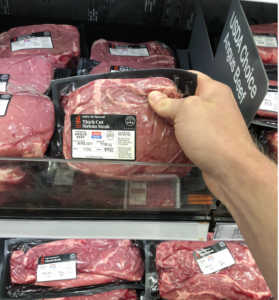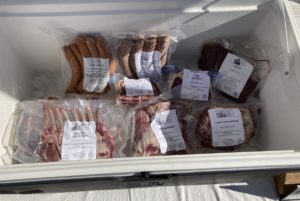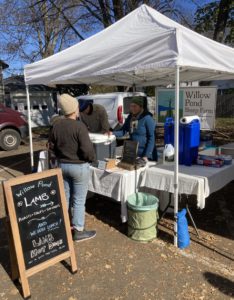Raising Prices on Meat: A Pep Talk
When raising prices, there are many factors to consider including local market, population, and economic conditions and seasonality in demand.
By Matthew LeRoux, with Todd Schmit and John Rogers

grocery-meat: A package of steak at a major grocery chain.
Matthew LeRoux / Cornell Cooperative Extension
Over the summer, we observed prices from 6 Ithaca grocery stores and 17 farms around NY. Farm prices are from farmers markets and farm-owned farm stores in Ithaca as well as other parts of the state. I found the results (below) to be quite surprising. Overall, grocery stores had higher prices for beef and lamb. Grocery store pork that was differentiated by the feeding or handling was also more expensive than farm price averages.
In this discussion, differentiated meats are those that are marketed for attributes to set them apart from conventionally produced meats. Differentiation can come from breed, feed, handling, certifications, and geography. For our comparison, we looked at conventional meats as well as two groups of differentiated meats. By default, locally raised meat marketed by the farm is differentiated, if for no other reason than it is locally raised, supporting local agriculture and the economy.
Any individual NY farm likely has higher costs than the system that supplies grocery stores. In addition to production costs, farms selling their own meat have higher trucking, processing, and marketing costs relative to grocery stores. Thus, it is unlikely that any NY farm can profitably bring meat to market at prices lower than stores. This makes me think that many NY farms need to revisit their pricing and account for their costs, especially their time. Raising prices is intimidating, no doubt. We all have affordability on our mind and are nervous to raise prices on our customers. Thus, what follows is a pep talk about prices.
- Consumers are already paying “high” prices for meat.
Lamb cuts from Willow Pond Sheep Farm on display at a farmers market.
Matthew LeRoux / Cornell Cooperative ExtensionBased on the prices observed at Ithaca stores and farms this summer, most farms could raise prices WITHOUT charging significantly more than the stores. For example, a consumer walking into an Ithaca grocery store seeking a ribeye steak is going to pay $15.85 on average (see Table 2), regardless of whether they seek a differentiated product or not! If customers are paying that price for an “ordinary” steak, certainly shoppers seeking differentiated steaks are willing to pay more. Customers who shop at farmers markets and farm stores are not necessarily price-driven shoppers. It is more likely that such shoppers are seeking products differentiated by breed, feed, handling, or simply location. These consumers are likely more willing to pay premium prices (above conventional product prices).
- Your target customers already value what you produce. Many farmers worry about customer reactions and the possibility of losing customers over price increases. Indeed, certain customers may leave and not return upon seeing a price increase; however, those customers are not your target customer! For local, farm-raised meat sold by the cut at farm stores and farmers markets, the target customer is one who already values what you produce. Customers who seek only the lowest price are not compatible with these channels or products, perhaps you can sell them a quarter or half instead.
- Fewer units sold is not the same as less money earned. Losing customers or product sales volume due to increased prices is possible, but it does not necessarily mean losing dollars in sales. For example, the farm average price for one pound of ground beef (not grass-finished) is $6.29 (Table 2). The grocery store average price for grain-finished, no antibiotics, no added hormones, 80/20 ground beef was $7.85/LB (Table 2). If a farm were to raise their price from $6.29 to $7.85 they could observe a reduction in sales from 80 to 64 lbs. and still gross nearly the same amount (see Table 1). Moreover, they will have another 16 lbs. of ground beef to sell! Jumping a price straight from $6.29 to $7.85 may be a bit abrupt but steady and gradual increases planned over time can ease the shock regular customers might experience.
Table 1: Price increases that result in selling fewer units do not necessarily result in reduced sales ($).
| Ground Beef Price/LB (P) | LBS Sold (Q) | Total Sales (PxQ) |
| $6.29 | 80 | $503.20 |
| $7.85 | 64 | $502.40 |
| $7.85 | 80 | $628.00 |
When discussing the impact of price changes on sales, time must be considered. In the example in Table 1, we assume that the drop in sales from 80 to 64 units occurs over a given a period, perhaps pounds sold per month. The point is that while the units sold in a given time period might fall, gross sales are approximately equal. Once all 80 pounds of ground beef are sold, the farm has realized an extra $125 in ground beef sales. Since most farms sell frozen meat, we can think of the product as having low perishability. The perishability of meat, or rather its preservation in the freezer, allows the seller to store the product and sell at the price needed for profit.
- Prices can be used to aid inventory management. Farms selling meat wrestle with the need to sell every cut on the carcass. Consumers love to buy premium steaks and bacon, but for each pound of popular cuts, there are also several more pounds of less desirable meat to sell. Pricing can be used to manage the rate at which cuts sell (over time). Higher prices on popular cuts will “slow down” sales and give the seller an opportunity to direct customers to other cuts. Customers seeking a ribeye steak may be surprised by the farm’s high price but that doesn’t mean they need to leave empty-handed. Rather, there is an opportunity to move the customer “down carcass” to cuts with lower prices that the farm needs to sell. In fact, the new Cornell Meat Price Calculator (under development) allows farms to experiment with different pricing scenarios while ensuring they reach their targeted profit goal. Increasing prices on cuts that tend to sell out quickly may allow the lowering of prices on other cuts that tend to sell slowly. In this way, farms can develop pricing scenarios that more closely match the pounds/carcass of cuts to the pounds sold in time, effectively managing inventory to avoid selling out or stockpiling cuts.
- Price elasticity.
Carrie Wasser of Willow Pond Sheep Farm sells lamb at the Rhinebeck Farmers Market.
Matthew LeRoux / Cornell Cooperative ExtensionConsumers encounter price changes regularly and they are used to them. How they react to price changes can be summarized in a term called the price elasticity of demand. It is a measure of how much demand changes to a change in price. In the case of inelastic responses, the percentage change in demand will be less than percentage change in price; i.e., the elasticity will be less than one. With aggregate level data, price elasticities of demand for meat products are commonly found to be inelastic, e.g., a recent study using aggregate data found own-price elasticities for “all” beef, pork, and poultry in the U.S. to be around -0.2, -0.5, and -0.7. Specifically, a 1% increase in the price of beef reduces demand by 0.2%. When demand is inelastic, increases in prices will result in an increase in total revenue ($) because the price increase (a positive influence on sales) more than offsets the decrease in demand (a negative influence on sales). In short, when your products have inelastic demand responses, you have an opportunity to increase sales revenues through price enhancement. Of course, elasticities on individual cuts and in individual markets will vary (e.g., ground beef is likely more price inelastic than a ribeye steak), but knowing how consumers react to prices in local markets is extremely helpful in pricing decisions. Remember, we all experience price changes on the products that we purchase, often we don’t even notice. Those changes don’t usually mean that we completely stop buying the products. Our current research with livestock producers will allow us to estimate elasticities from their sales data. Stay tuned!
Summary: Raising prices can feel like a challenging task. There are many factors to consider including local market, population, and economic conditions and seasonality in demand. Ultimately, pricing must originate with the farm’s costs and profit goals. Observing prices at grocery stores can be surprising and may challenge our assumptions about store versus farm prices. Store prices may also give the farm confidence to make changes, knowing that consumers are already paying these prices for non-differentiated products.
Table 2. Farm and grocery store meat prices observed from June 28 to August 18, 2021, Ithaca, NY.
| AVG PRICE/LB
N=sample size R = range |
Conventional | Natural | Pasture-raised, Grass-fed and/or Organic | ||
| Store Prices | Store Prices | Farm Prices | Store Prices | Farm Prices | |
| Beef | |||||
| Chuck Roast | $7.17 N=13
R=5.99-8.69 |
$11.49 N=3
R=11.49-11.49 |
$6.43 N=3
R=4.80-9.50 |
$8.45 N=3
R=6.78-9.29 |
$6.85 N=5
R=6.00-7.25 |
| Ground Beef, 80/20+ | $5.29 N=17
R=3.39-6.89 |
$7.85 N=5
R=7.29-8.69 |
$6.29 N=3
R=4.88-9.00 |
$6.47 N=12
R=4.65-9.99 |
$6.00 N=6
R=5.50-6.50 |
| Ground Beef, 90/10+ | $6.12 N=16
R=4.49-6.99 |
$8.54 N=2
R=8.29-8.79 |
$7.78 N=17
R=4.99-10.99 |
||
| Ribeye Steak | $15.85 N=12
R=11.97-17.99 |
$26.94 N=4
R=26.32-28.78 |
$12.49 N=3
R=11.49-14.00 |
$17.82 N=5
R=9.99-25.49 |
$14.67 N=6
R=11.00-18.00 |
| Sirloin Steak | $10.40 N=12
R=7.99-11.99 |
$14.49 N=1
R=14.49 |
$9.15 N=3
R=7.99-9.97 |
$17.69 N=4
R=14.64-25.49 |
$10.83 N=6
R=7.00-13.00 |
| Pork | |||||
| Ground Pork | $4.06 N=9
R=2.89-5.54 |
$5.42 N=3
R=3.99-6.14 |
$6.07 N=4
R=4.79-7.00 |
$7.19 N=2
R=7.19 |
$5.92 N=6
R=5.00-8.00 |
| Pork Chop, Bone-in | $4.57 N=14
R=3.79-5.39 |
$8.66 N=3
R=8.66-8.66 |
$6.11 N=5
R=4.99-7.00 |
$10.12 N=3
R=10.12 |
$9.75 N=7
R=7.00-16.00 |
| Pork Tenderloin | $4.49 N=10
R=2.29-4.99 |
$6.08 N=3
R=3.99-7.27 |
$9.07 N=2
R=5.14-13.00 |
$14.99 N=3
R=14.99-14.99 |
$11.00 N=2
R=8.00-14.00 |
| Lamb | |||||
| Ground Lamb | $8.46 N=3
R=8.19-8.99 |
$8.27 N=3
R=7.44-8.69 |
$9.00 N=1
R=9.00 |
$7.32 N=3
R=6.99-7.49 |
$11.50 N=4
R=9.00-15.00 |
| Lamb Loin or Rib Chop | $17.49 N=4
R=17.32-17.99 |
$22.69 N=7
R=15.78-31.32 |
$13.00 N=1
R=13.00 |
$14.99 N=1
R=14.99 |
$18.80 N=5
R=12.00-25.00 |
Note: Some farm pork chops did not distinguish “bone-in” or “boneless.” Farm ground beef did not specify a lean/fat ratio.
Natural: Products with label claims of “no antibiotics” and/or “no added hormones.”
Conventional: Products without claims that refer to handling/feeding and those referring to “natural” on the label where it is defined as “minimally processed.”
Pasture-raised, Grass-fed and/or Organic: Products with primary label claims including pasture-raised, grass-fed and/or USDA Certified Organic.
Ground Beef, 80/20+: Ground beef products with a lean/fat claim of 80/20 or 85/15.
Ground Beef, 90/10+: Ground beef products with a lean/fat claim of 90/10, 93/7, 95/5, or 96/4.



